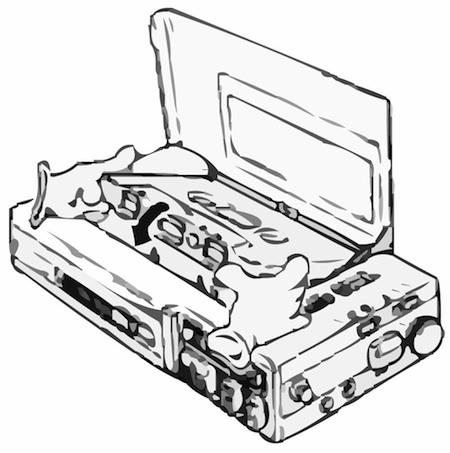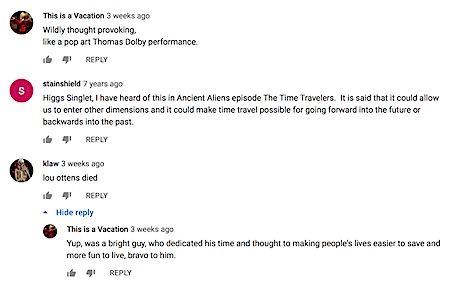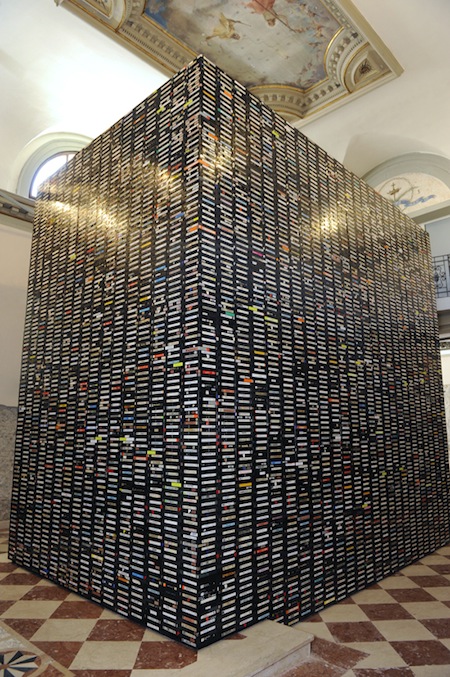5 min read 🤓
[ re-blogged from langlevelououttens.tumblr.com. The following text was originally written in 2011 as an invited contribution to a book with a collection of things dedicated to cassettes and cassette culture, but somehow that book never got published (I think) [the booklet in question actually appeared shortly after the publication of this SoundBlog entry. Read more about that in De Val van Chroom / The Fall of Chrome]. Some of our regular viewers will remember Penelope Audela. So, how is Penelope doing these days? She's deep into directing, and doing fine... ]
[ As a streamable contribution to the 2012 = C50 event in the Silent Barn in Brooklyn, NY, on Sunday March 17th 2013, I recorded a video of me reading the text. ]
Higgs singlet decay particles pop into my universe at random times
february 22, 2013.
This happened not so very long ago. It was at a time when the cheap, small and versatile digital dictaphones, that permit one to record sounds lasting up to several days at a stretch, were still part of a future to be. Inspired and deeply impressed by the lifelong nihilist but mindful work that the French novelist George Perec (in his La Vie, Mode d'Emploi) attributes to an eccentric and very wealthy Englishman named Bartlebooth, a dear and equally prosperous friend of mine took it upon her to record, complete and unabridged, the soundtrack of her life. My friend embarked upon her project while the state of the art in technology for simple and powerful personal portable audio recording came with a little reel of magnetic tape kept inside a small box made out of plastic: the compact cassette, created in the 1960s by ir. Lou Ottens and his R&D team at the Dutch multinational Philips Electronics Inc. ( i )
During 20 consecutive years, Penelope Audela etched the sounds of her life in magnetized rust onto these long and narrow plastic ribbons. ( ii )

She did so from July 16th, 1984 until July 26th, 2004, and recorded 144.567 hours of sound on 144.567 compact cassettes, all of them C60 and of type I. Penelope numbered the cassettes by hand, from 1 to 144.567. She stored them in a cellar that belongs to the estate where she grew up (near Meerssen, a small village in the south of the Netherlands, not far from my hometown Maastricht), in twenty custom made wooden cabinets, one for each of the twenty years. Each cabinet has 15 drawers. In each drawer there is room for 11 rows of 51 cassettes.
The first time she took me down there, Penelope smiled a malicious little smile. "Voilà," she said. "The best years of my life."
I actually was surprised to find that 20 years worth of cassette tape recordings filled up so little space. Also Penelope herself originally largely overestimated the amount of tape that this twenty year long self-imposed around the clock ploughing of sounds would consume. For a while she had toyed with the idea to, afterwards, splice all tape together into one mega-thread, that she then somehow (in an act vaguely inspired by her friend Jeanne-Claude) would wrap around the globe. But she had to give up on that: she realized that the total length of tape amassed over twenty years of continuous recording would only amount to (a little less than) 12.500 kilometers, which, unfortunately, would not even get her one third of the way around the world.
She then decided, simply but profoundly, to not do anything at all. She would just let the tapes be. Over time all of the sound that was captured on her cassettes would gradually disintegrate, along with the magnetic emulsion that kept them, and slowly disappear. Indeed. There is no doubt that given the insuperable, slow but steady, decay of all magnetic media, within less than a lifetime nothing will remain but 12.500 kilometers of hissing non-sound.
Plastic.
Snake.
Tape.
While waiting for this to eventually come about, Penelope gave me custody of her unique collection. She has appointed me as her tapes’ caretaker and her recordings’ curator. Which is a dubious honor, to say the least.
For how can I ever listen to all that is on them? How shall I decide what tape to pick, what tape to leave? Should I maybe listen to that day, rather than this day?
Should one even listen at all?
I have been back down into the cellar only a handful of times over the past couple of years. At each occasion I took some of the cassettes home with me. I just picked them at random. The sounds that I find on there, I set loose every now and then. They pop into our universe at random times, like the decay particles of a Higgs singlet travelling in a fifth dimension.

"Each of these 144.567 hours is like a skin that I shed," Penelope once told me. "I've been shedding skins for twenty years, and at the end of these twenty years there was as much still left as the day that I began. It's impossible to penetrate."
((...))
These skins are like branes, endlessly stacked atop other branes.
((...))
...
I remain open to proposals from institutions that would be interested in acquiring Penelope's plentiful skins, and willing to discuss conditions for their public display.
The total volume of all 144.567 of tapes is about 20 cubic meter.
Together they weigh some 10 tons.
In accordance with the collection's impenetrability, I propose the cassettes to be displayed as a single solid block, with a ground surface of 2.5 x 4 meters and a height of 2 meters.
For almost all of it is and will remain inaccessible, for ever and ever.
Most sounds, yes, we never hear.
There's but few that we do, when suddenly, without warning, like fish from the depths of the sea to leap at the bait, they come rising to the surface.
March 14th, 2011
YouTube reading
Added April 4th 2021:

Added December 23rd 2013:
Some time after the publication of this SoundBlog entry, hence quite a while after having written the above account of Penelope's quest, I stumbled upon Lifespan, an installation - from 2009 - by two Australian artists, Claire Healy and Sean Cordeiro.
Lifespan consists of 175.218 VHS video cassettes, arranged in a solid block.
"The combined running time of these cassettes, if played consecutively, would be 60,1 years, which was the average human life span in 1976 – the year that the VHS was released."

...
notes __ ::
(i) See: STRP S K7 HISSSS [
^ ]
(ii) My friend’s name has been changed, to warrant her privacy.[
^ ]
tags: Lou Ottens, cassette, Higgs, Penelope Audela, Lifespan, Claire Healy, Sean Cordeiro
# .434.
comments for Higgs singlet decay particles pop into my universe at random times ::
|
Comments are disabled |
